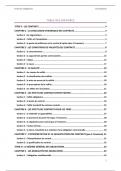Summary
Résumé Synthèse - Droit des obligations
- Course
- Institution
Ce document regroupe toute la matière du droit des obligations vue en bac 1 à l’Ephec. Il se compose d’une table des matières interactive dont les titres principaux sont : Titre I - Notions général (absent), Titre II - Les contrats, Titre III - Le régime général des obligations, Tit...
[Show more]



